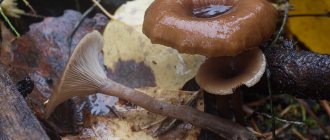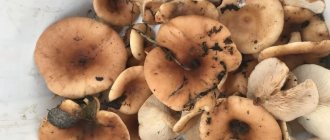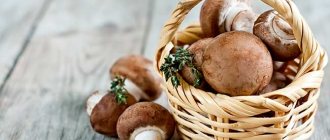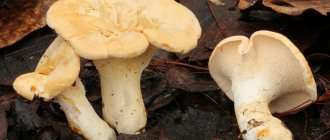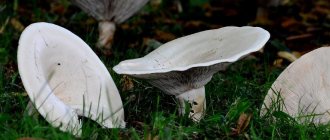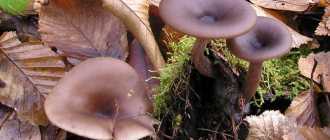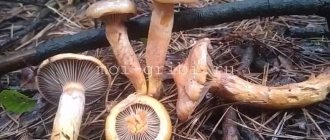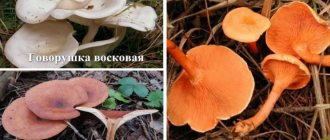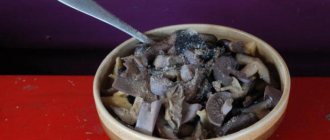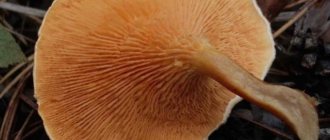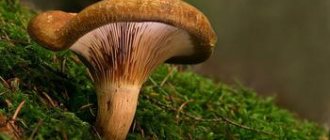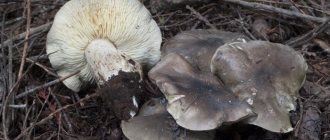| Name: | Talker |
| Type: | Edible |
Talker mushrooms are a common type of mushroom, including both edible and poisonous specimens. They are used to prepare many dishes, so they should be collected with great care. Photos and descriptions of talker mushrooms will help you avoid making mistakes when collecting.
What talkers look like
The cap of this mushroom is modest in size - its diameter is 4-8 cm, in rare specimens it grows to 15-20 cm. In young ones it has the appearance of a hemisphere, over time it becomes flat, and in old ones it may have a funnel in the center.
The surface of the cap is dry and smooth, has a brown-gray, ocher, beige or brownish-pinkish color. Color saturation decreases from the middle to the edges. Sometimes on the surface you can notice the remains of mycelium, reminiscent of mold spots.
The plates located on the inside of the cap are usually white. The older the mushroom, the closer to yellow their shade is.
The leg of various types of talkers can have a height from 4 to 10 cm and a diameter of 1-3 cm.
The pulp of young specimens is quite dense and white; as the mushroom ages, it becomes drier.
Spore powder is white or cream in color.
Fruiting period
Collecting the gray talker is very pleasant. It is clearly visible in the forest and seems to fall into the hands of the mushroom picker. This variety of talkers is characterized by an unusual and very pleasant fruity-floral aroma, which makes it easily different from other mushrooms that are similar in appearance.
The mushroom stem is quite tough
For normal fruiting, the talker needs quite high humidity. Therefore, it appears only after enough rain. In dry years it can be found extremely rarely. It grows from August to late autumn, but more abundantly from September to mid-October. If there are favorable weather conditions, the fruiting period extends until mid or late November.
Types of talkers
The genus includes more than 250 species of mushroom. About 60 different talkers are known and studied in our country. Among them you can find both quite edible and very poisonous ones. Therefore, it is necessary to have a good understanding of what a particular species looks like and whether it is safe to collect. Photos of edible talkers and their poisonous counterparts will help with this.
The most common types of talkers:
- The bent talker is an edible species with a wide cap, the size of which can reach 18 cm, and a gray-yellow color. Young mushrooms have a slightly convex cap, while older mushrooms have a funnel-shaped cap with a raised area in the middle. The plates are frequent and white. The stem is strong, the same color as the cap, 12-20 cm high and up to 3 cm thick. The flesh is white, in older mushrooms it is brownish. In the upper part it is strong and elastic, and on the stem it is more porous and dry. Such a talker can grow either as individual fungi or in groups in the form of large circles. It can be found in deciduous forests and forest edges. The harvest period is from late summer to October. It has a poisonous counterpart - entoloma, but unlike the folded talker, the cap of entoloma is flat, and the flesh has an unpleasant rancid odor.
- Gray or smoky talker is an edible mushroom. The cap, like that of other varieties, is initially dome-shaped, and over time it becomes smooth with a small depression. The color of the cap is light gray or brownish. The plates are frequent, white or yellow with a grayish tint. The lower part of the fruit body is strong, low, 3-4 cm thick, white-gray in color. The flesh of the cap is strong and juicy, while the stems are drier and have a sharp soapy smell. It lives in deciduous or coniferous forests, often in large groups. The fruiting period is from August to the end of autumn.
Delicious recipe! Rice for bloating
- Goblet talker is an edible mushroom. Its cap is shaped like a cup or glass with the edges bent outward. The cap size is 5-8 cm, the color is brown or brown-gray. The plates are sparse and brown. The stem is hollow, 9-12 cm high. The flesh of the mushroom is watery, off-white in color. Grows in forests among fallen leaves or pine needles. The period of active growth is August-September.
- Orange talker (otherwise known as false chanterelle) is an edible mushroom with a funnel-shaped cap with bent edges of a bright orange color. The leg is also orange, smooth, 5-8 cm high. They grow singly or in small groups in mixed or coniferous forests among moss and fallen leaves. The fruiting period is from August to October.
- The club-footed talker is a conditionally edible mushroom. The cap in young specimens is spherical, and in more mature ones it is in the form of a funnel, brown or gray-brown in color, 6-8 cm in size. The plates are sparse, cream-colored. The leg is club-shaped, which gave the name to the species, fibrous grayish-brown, no more than 7-8 cm high. The pulp is thin, moist, with a slight smell of flour. Lives in coniferous or mixed forests, in single specimens or in groups. The fruiting period is from August to October.
- Funnel-shaped or funnel-shaped talker is a conditionally edible mushroom, the most common variety. The cap is initially flat with a rise in the center, and as it grows it takes the form of a funnel. The size of the cap does not exceed 7-8 cm. The color is yellowish-brown. The plates of this variety are frequent, descending along the stem. The lower part of the fruiting body is thin, hard, 8-10 cm high. The mushroom grows singly or in groups in forests on a litter of fallen leaves or pine needles. The fruiting period is from August until the start of frost. Only young specimens can be used for food, after first boiling them for at least an hour.
- Aniseed or fragrant talker is an edible, rarely found mushroom. The hat, like that of other “relatives”, is slightly curved at first, and as it grows it becomes cup-shaped. The color is grey-green. The plates are white or pale green, adherent to the base. The leg is gray-yellow, the size does not exceed 6 cm. The pulp is pale green, watery, with a pronounced anise smell. Grows in mixed forests in groups of several. The fruiting period is from late summer to October.
Spreading
This mushroom is quite widespread in the temperate climate zone. It is found in mixed and coniferous forests with a predominance of spruce, with which it forms mycorrhiza. It feeds on wood that has already begun to decompose, thus participating in its processing. You can often find it in clearings, clearings, near dead wood, and in places where trees are cut down. It rarely grows alone, more often it appears in fairly large groups, forming rows and circles.
Attention! The pulp of the smoky talker is loose and easily absorbs various substances harmful to humans from the environment. Therefore, it must be collected exclusively in clean places, away from roads, industrial enterprises and landfills.
Is it possible to eat talkers?
The genus of talkers includes both edible and very poisonous subspecies. Due to the fact that it can be very difficult to distinguish inedible talker mushrooms from harmless ones, they are recommended to be collected only by experienced mushroom pickers. If there is even the slightest doubt about the edibility of a mushroom, it is better to refrain from collecting it.
Edible talkers are very nutritious and have a number of beneficial properties. The caps of young mushrooms are usually used for food. Before the main preparation, they must be boiled.
Edible or not
Gray talker belongs to the conditionally edible mushrooms. Its pulp cannot be consumed raw due to the high content of the toxic substance nebularin. During heat treatment, the toxin is neutralized, but eating these mushrooms in large quantities is not recommended. In cooking, only the caps of the smoky row are usually used, and the hard stem is removed.
Important! Only young fruit bodies collected in ecologically clean areas are suitable for use as food, since over time the pulp of the smoky row accumulates toxic salts of heavy metals.
Benefits and harm to the body
Edible talkers are a valuable source of protein and a number of vitamins and macro- and microelements (zinc, manganese, copper), thanks to which they have many beneficial properties:
If we talk about the dangers of mushrooms, we should remember that they accumulate heavy metals, so you should not collect them near enterprises or highways. Talkers should not be given to children under 12 years of age or to pregnant or lactating women. Any mushrooms are a heavy product, so if you have gastrointestinal diseases, you need to eat them with great caution.
Delicious recipe! Aquarius sign woman characteristics
Application in medicine
The substance nebularin, contained in the pulp of the sulfur talker, is a natural antibiotic that is used in the pharmaceutical industry to make medicines. In addition, mushrooms are used in folk medicine.
You will be interested in learning how to grow champignons in a greenhouse.
They are prepared from:
- ointments to improve skin condition and rapid wound healing;
- extracts that help with urolithiasis and colds.
How to cook talker mushrooms
There are a large number of recipes for making talkers. They are used for soups, sauces, main courses and preparations for the winter. The collected mushrooms must be washed, peeled and heat treated. You need to cook the talkers for at least 30 minutes. The resulting broth is poured out. After this, they can already be cooked.
Talker soup recipe:
- Potatoes must be peeled, cut into cubes or strips and placed in boiling water. Add bay leaf and a few black peppercorns. Boil the potatoes until half cooked.
- While the potatoes are boiling, you need to peel and chop the onions and carrots. Pour vegetable oil into a heated frying pan, add onions and fry a little, then add carrots and pre-boiled talkers. Simmer over medium heat for 10-15 minutes, remembering to stir.
- Remove the bay leaf from the broth and add the mixture from the frying pan to the potatoes. Cook for 10 minutes.
- Mix a little flour with cold water in a separate container and stir thoroughly. Pour the resulting mixture into the broth, stirring to avoid lumps. Add salt, spices and chopped herbs. Cook for another 5 minutes.
Govorushki baked with meat and potatoes:
- Cut the pre-boiled mushrooms and place them on a baking sheet greased with vegetable oil.
- Cut the meat into pieces and lightly beat it, place it on the mushrooms.
- Peel the potatoes, cut into slices and place on top of the meat.
- Each layer must be salted and spices added to taste, coated with sour cream.
- Place in a preheated oven for 40-45 minutes at 180°C.
- 5 minutes before ready, sprinkle grated cheese on top.
- Pre-boiled and crushed talkers are placed in a heated frying pan greased with vegetable oil.
- Add salt, pepper and spices to taste.
- Fry over low heat for 20-25 minutes.
- Add sour cream and simmer for another 5 minutes.
- Sprinkle with fresh herbs.
A variety of floodplains
Strictly speaking, there are no varieties of floodplains. There are more than 2,500 species of the family Ordinaceae. Some of them are considered varieties of the same mushroom. The following rows can be taken for undertopolnik:
- crowded;
- gray;
- earthy;
- green;
- brown;
- leopard print
Since these species have a similar growth mechanism (almost underground), they are often mistaken for varieties of floodplains. The fact that the growing places, descriptions and photos of these mushrooms do not coincide with sandpipers is of little concern to anyone. At most, they will be called a false sandpiper/row.
Comment! Podtopolnik is also called the value mushroom.
Most likely for the appearance. But the valui has not the slightest relation to the ordinary ones: it is a family of Russula. The photo shows not one of the types of floodplains, but a valui. He's a bull. It is enough to cut off the fruiting body to understand the difference: the stem of the row is dense, while that of the valuu is hollow.
How to salt talkers for the winter
You can also salt or pickle talkers for the winter.
The most common hot salting method is:
- Wash the collected mushrooms, peel and boil for 30 minutes.
- Place the boiled talkers in a saucepan and add hot, clean water and put on fire.
- Add salt at the rate of 200 g per 1 liter of water.
- Cook for 40 minutes.
- Place the talkers into jars.
- Prepare the brine: for 1 liter of water, 1 tbsp. l. salt, a clove of garlic, dill and 2-3 black peppercorns. Boil the brine for 3-5 minutes.
- Pour the resulting brine over the mushrooms so that they are completely covered.
- Close the jars and put them in a cool, dark place.
- After 10 days, the mushrooms are ready to eat.
Why is he dangerous?
An increase in protein in a woman’s urine can be noticed both in the first weeks of pregnancy and in the last (37-40 weeks). This can happen due to a number of reasons.
What does increased protein in urine mean in our article.
This can be caused by a natural process that occurs in the body, for example, an enlargement of the uterus (the uterus increases in size, thereby disrupting the normal blood supply to the urinary ducts and kidneys).
Diseases that provoke excess protein in the urine in pregnant women (see acceptable standards in the table below):
- infection of the urinary ducts;
- renal polycystic disease;
- hypertension;
- infectious kidney diseases (meaning: glomerulonephritis and pyelonephritis);
- high sugar due to diabetes;
- heart failure;
- gestosis.
The most dangerous factor in the appearance of traces of protein in the urine of a woman in an “interesting” position is a disease called gestosis.
symptom
Typically, gestosis manifests itself in the second trimester of pregnancy. This disease disrupts the normal development of the placenta, thus putting the unborn baby in danger. The fetus does not receive the required amount of oxygen and nutrients.
Such phenomena usually provoke premature birth, and worse, slow development of the fetus.
If the pathology is not detected in time and no action is taken for treatment, the baby may be born dead.
Less dangerous causes of the appearance of protein in the urine, such as pyelonephritis and glomerulonephritis, can also have serious consequences.
The first is characterized by pain and discomfort in the lower back and bladder. An indicator of the second is the unusual color of urine - the presence of a fleshy color. With pyelonephritis and glomerulonephritis, in addition to the presence of protein, a large presence of leukocytes and red blood cells is manifested in the urine.
The condition of a pregnant woman is in itself characterized by unpredictability. A woman in an “interesting” position may not even be aware of any abnormalities in her body, because before pregnancy everything was normal. In addition, after childbirth, all the problems that were present during pregnancy disappear.
How to marinate talkers correctly
Among the kingdom of talker mushrooms there are a countless number of species, both edible and “not so edible”. Therefore, if you decide to cook talkers, make sure: is it the right mushroom? In general, talker, although experts classify it as the fourth group, has antibacterial properties, contains many vitamins such as B1 and B2, as well as trace elements: copper, zinc, manganese. That's why it's worth stocking up on pickled talkers.
Delicious recipe! White mushroom pickling recipe
To marinate the talkers, we will need: • Talkers – 1 kg; • Water – 0.5 cup (150 ml); • Vinegar 9% - 0.5 cups; • Salt – 2 tablespoons; • Cloves – 4 pieces; • Dill – 30 gr; • Bay leaf – 2 leaves; • Ground cinnamon – 0.5 teaspoon; • Peppercorns – 10 peas; • Sunflower oil – 30 ml. 1. The first thing to do is to carefully and carefully sort out the talkers and rinse them with plenty of water. Young, dense and immature mushrooms are suitable for pickling; it is best to take small caps of young mushrooms, and cut larger caps into halves and quarters. 2. After this, the mushrooms are transferred to an enamel bowl and boiled in salted water until ready: for 1 liter of water - 50 g of salt and 2 g of citric acid. It takes 20-30 minutes to cook. Remove the foam that forms during cooking with a slotted spoon. As soon as the mushrooms sink to the bottom, cooking is considered complete. 3. Mushrooms are discarded in a colander to separate the liquid, placed in sterilized jars and poured with pre-prepared marinade. 4. For the marinade, pour water into an enamel pan, add salt, spices (bay leaf, cloves, ground cinnamon, peppercorns, dill), add vegetable oil and vinegar. Boil for a few minutes. 5. Roll up the jars with metal boiled lids, cool and store. And in winter you can eat it as a separate snack, or add it to various salads, stew potatoes, and meat. Bon appetit!
Chemical composition
The smoky govorushka is considered a mushroom of low quality and looks inconspicuous in the photo, but it belongs to dietary products.
Nutritional value of 100 g of pulp:
- calorie content - 30 kcal;
- proteins - 3.7 g;
- fats - 1.7 g;
- carbohydrates - 1.1 g.
In addition, the following important elements are present in the composition of the smoky row pulp:
- vitamins B1, B2, B4, B5, B6, B9, D, D2, PP;
- microelements - iron, selenium, zinc, copper, manganese;
- macroelements - calcium, sodium, phosphorus, potassium, magnesium;
- monosaccharides and disaccharides, glucose, starch;
- essential amino acids - phenylalanine, valine, histidine, leucine, methionine, lysine, isoleucine, threonine, arginine, tryptophan;
- nonessential amino acids - glycine, cysteine, alanine, proline, tyrosine, serine, glutamic and aspartic acids;
- saturated fatty acids - arachidic, capric, palmitic, behenic, stearic, pentadecanoic, myristic, margaric, lignoceric;
- monounsaturated fatty acids - Omega-9, myristoleic, palmitoleic;
- polyunsaturated fatty acids - Omega-6, linoleic.
Did you know? The most poisonous variety of rowers is the leaf-loving govorushka (Clitocybe phyllophila). Its pulp has a pleasant taste and smell, but causes severe intoxication of the body, which can be fatal.
